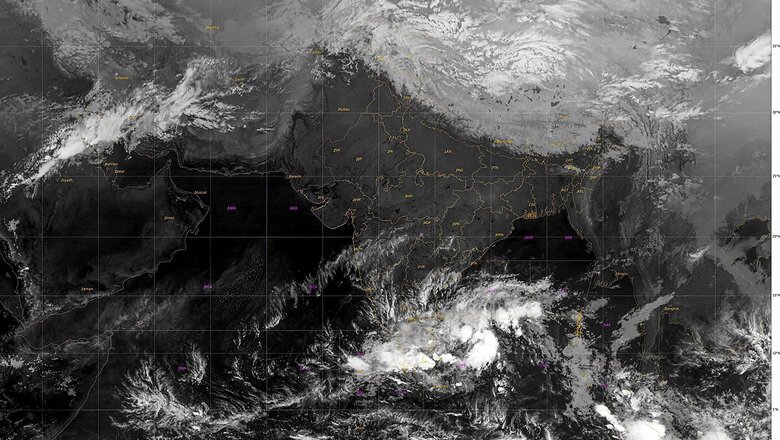
views
Heavy rains pounded Tamil Nadu and Puducherry on Friday, inundating several low-lying areas, while the weather in the northern parts of the country remained mostly dry barring Kashmir.
Incessant rains in Tamil Nadu led to inundation of crops and waterlogging in many rural and urban areas even as the deep depression over Gulf of Mannar near Ramanathapuram weakened into a depression. The India Meteorological Department said the deep depression over the Gulf of Mannar close to Ramanathapuram district’s coast remained practically stationary for 18 hours and then weakened into a depression.
“The depression is likely to remain practically stationary over the same (Ramanathapuram) region and weaken into a Well marked Low Pressure Area during the next 12 hours (by early Saturday),” the latest bulletin said. While there was widespread rainfall covering many parts of the state, several regions reported heavy to extremely heavy rains, including Kollidam (36 cm,Nagapattinam district), Chidambaram (34 cm, Cuddalore).
In a relief to Kerala, the Met department withdrew the red alert issued for cyclone Burevi and rains in the seven southernmost districts of the state owing to the weakening of the deep depression into a depression. In Delhi, the air quality remained “very poor” and no significantchange was predicted soon.
The national capital’s air quality index (AQI) was 364 at 9 am. The India Meteorological Department said the minimum temperature was 8 degrees Celsius and the maximum was 28.8 degrees Celsius. The minimum temperature this season has remained 2-3 degrees Celsius below normal in the absence of a cloud cover on most days, according to IMD officials.
Further norrth, several parts of Kashmir received rainfall while there was snowfall in the upper reaches of the valley. The weatherman said the western disturbance is expected to affect the weather system in J-K till December 10 and the weather is expected to remain wet with light to moderate rainfall and snowfall in the hilly areas of the valley. Pahalgam was the coldest with minus 2.5 degrees Celsius while Gulmarg and Srinagar recorded a low of minus 2.2 and 1.2 degrees Celsius respectively. Kokernag and Bandipur were the two weather stations where mercury was recorded above freezing points last night.
In the hills, the weather in Himachal Pradesh remained dry with Keylong in Lahaul and Spiti district being the coldest recorded place in the state at minus 6.9 degrees Celsius. The weatherman has predicted rains and snowfall in middle and high hills of the state in coming days.
Rain and snowfall is likely to occur at isolated places in middle hills from Monday and Tuesday and in high hills from Mondayto Thursday, the weatherman said. Kalpa in Kinnaur district recorded a low of 0.1 degrees Celsius while the minimum temperature in Manali, Kufri and Dalhousie was 2, 7.7 and 7.9 degrees Celsius respectively. In parts of Rajasthan, night temperatures hovered several notches above normal limits, with Sikar recording the lowest night temperature at 8 degrees Celsius.
There has been a change in the wind pattern and due to the impact of westerly winds temperatures have slightly risen in the last couple of days, a MeT department official said. In Haryana and Punjab, the minimum temperatures hovered above the normal limits at most places. At some places in the two states, including Ludhiana and Patiala in Punjab and Ambala, Karnal, and Kaithal in Haryana, fog reduced visibility early in the morning.
The minimum temperature at Chandigarh settled at 10.6 degrees Celsius, up three notches against normal. While in Haryana, Ambala recorded a low of 9.3 degrees Celsius, Amritsar in Punjab recorded a low of 11 degrees Celsius, seven notches above normal.
Churk was the coldest at 6.6 degrees Celsius in Uttar Pradesh, where the weather remained dry with dense to very dense fog at isolated places with no change in day temperatures. Basti recorded the highest maximum temperature in the state at 32 degrees Celsius in Jhansi district. In the south, heavy rains continued to pound Tamil Nadu leading to inundation of crops and waterlogging in many rural and urban areas. The IMD said the deep depression over Gulf of Mannar, near Ramanathapuram district’s coast remained stationary, about 40 km southwest of Ramanathapuram and it would remain stationary over the same region and weaken into a depression during the next 12 hours and then into a well-marked low pressure area.
Heavy to extremely heavy showers was also reported in Kollidam (36 cm, Nagapattinam district), Chidambaram (34 cm, Cuddalore) and over two dozen areas received between 10 and 28 cm rain. Crops including paddy and sugarcane were inundated in districts including Tiruvarur, Thanjavur, Mayiladuthurai, Nagapattinam, Pudukottai and Ariyalur falling under the Cauvery delta zone and complete submergence of agricultural fields was also seen as showers continued for the third successive day.
While Chennai received moderate rains, Madurantakam near here recorded 10 cm. On December 3, cyclone ‘Burevi’ weakened into a deep depression. Heavy rains also lashed Puducherry and its suburban areas recording around 14 cm of rainfall. Several housing colonies and main thoroughfares were waterlogged as a result of the torrential rains while power supply was disrupted for several hours in some localities.
There was respite for Kerala as the Met department withdrew the red alert issued for cyclone Burevi and rains in the seven southernmost districts of the state. The IMD has issued yellow alerts for the districts of Thiruvananthapuram, Kollam, Pathanamthitta, Alappuzha, Kottayam, Ernakulam, Idukki, Thrissur, Palakkad and Malappuram.
Meanwhile, the Thiruvananthapuram International Airport had rescheduled nine flights scheduled for Friday. The state has also opened over 2,000 relief camps to face any contingencies as heavy rains were expected when cyclone Burevi made landfall.
Read all the Latest News, Breaking News and Coronavirus News here




















Comments
0 comment